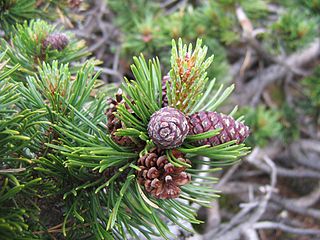
Pinus mugo, known as bog pine, creeping pine, dwarf mountain pine, mugo pine, mountain pine, scrub mountain pine, or Swiss mountain pine, is a species of conifer, native to high elevation habitats from southwestern to Central Europe and Southeast Europe.
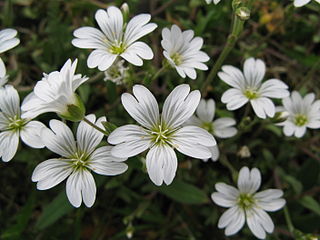
Cerastium is a genus of annual, winter annual, or perennial plants belonging to the family Caryophyllaceae. They are commonly called mouse-ear chickweed. Species are found nearly worldwide but the greatest concentration is in the northern temperate regions. There are about 200 species. A number are common weeds in fields and on disturbed ground.

Sidalcea candida, the white checkerbloom, prairie mallow or white checkermallow, is a wildflower found from Nevada to Wyoming and south to the southern part of New Mexico. The plant grows to three feet, and is also known as wild hollyhock. Its flowers are about one inch wide with five petals. It is found mostly in mountain meadows and along streams. It flowers between June and September.

Cerastium biebersteinii, the boreal chickweed, is an ornamental plant in the genus Cerastium and the family Caryophyllaceae. It is an endemic of the Crimea. The species is named after a German botanist Friedrich August Marschall von Bieberstein.

Thermopsis montana, the false lupin, mountain goldenbanner, golden pea, mountain thermopsis, or revonpapu, is a plant species which is native to the western United States. The Latin specific epithet montana refers to mountains or coming from mountains.

Rubus deliciosus is a North American species of flowering plant in the rose family Rosaceae, native to the United States. Common names include the delicious raspberry, boulder raspberry, Rocky Mountain raspberry or snowy bramble.

Rhododendron macrophyllum, the Pacific rhododendron, California rosebay, California rhododendron, coast rhododendron or big leaf rhododendron, is a large-leaved species of Rhododendron native to the Pacific Coast of North America. It is the state flower of Washington.

Cerastium glomeratum is a species of flowering plant in the family Caryophyllaceae known by the common names sticky mouse-ear chickweed and clammy chickweed. It is probably native to Eurasia but it is known on most continents as an introduced species. It grows in many types of habitat. The blooming period is February, March, April, and May.

Cerastium arvense is a species of flowering plant in the pink family known by the common names field mouse-ear and field chickweed. It is a widespread species, occurring throughout Europe and North America, as well as parts of South America. It is a variable species. There are several subspecies, but the number and defining characteristics are disputed.

Eriophorum gracile is a species of flowering plant in the sedge family, Cyperaceae. It is known by the common name slender cottongrass, or slender cottonsedge. Eriophorum gracile is a plant with circumboreal distribution, extending south into mountain ranges of the Northern Hemisphere. It grows in wet areas such as bogs.
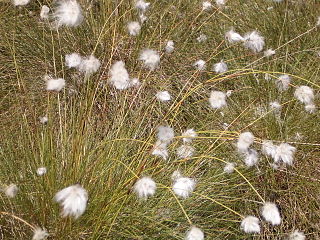
Eriophorum vaginatum, the hare's-tail cottongrass, tussock cottongrass, or sheathed cottonsedge, is a species of perennial herbaceous flowering plant in the sedge family Cyperaceae. It is native to bogs and other acidic wetlands throughout the Holarctic Kingdom. It is a 30–60 cm high tussock-forming plant with solitary spikes.
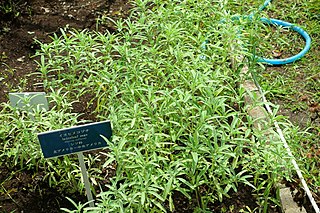
Salvia reflexa, the lanceleaf sage, Rocky Mountain sage, blue sage, lambsleaf sage, sage mint or mintweed, is an annual subshrub native to the United States and Mexico and introduced to Argentina, Australia, Canada, South Africa and New Zealand.
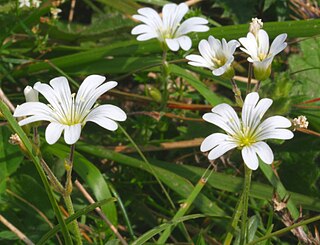
Cerastium alpinum, commonly called alpine mouse-ear or alpine chickweed, is a mat-forming perennial plant. The species was first described by Carl Linnaeus in 1753. It is native to Greenland, Canada and northern Europe. It is grown as a rock garden subject for its many small white flowers and silver haired stems and foliage. There are three subspecies.

Cerastium brachypetalum, commonly called gray chickweed, grey mouse-ear or gray mouse-ear chickweed, is a spring blooming annual plant species. It is native from Eurasia and introduced and naturalized in North America.

Cerastium fontanum, also called mouse-ear chickweed, common mouse-ear, or starweed, is a species of mat-forming perennial or, rarely, annual plant. It is native to Europe but introduced elsewhere. Its identifying characteristics are tear-shaped leaves growing opposite one another in a star pattern, hairy leaves, and small white flowers. Mouse-ear chickweed typically grows to 4"-8" tall and spreads horizontally along the ground via the formation of roots wherever the stem falls over and contacts the ground.
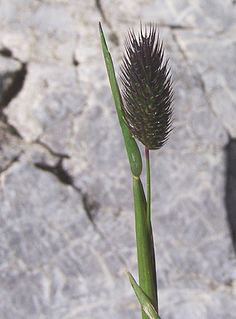
Phleum alpinum is a species of grass known by the common names alpine cat's-tail, alpine timothy and mountain timothy.
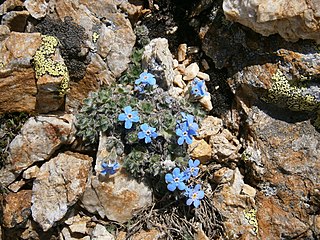
Eritrichium nanum, the arctic alpine forget-me-not or king-of-the-Alps, is a circumpolar alpine cushion plant which occurs in the North American Rocky mountains as well as the European Alps. It grows at elevations of 10,000 feet in an environment of acid rocks, snow gullies and receding glaciers.
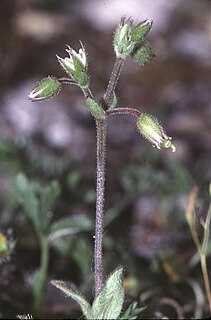
Cerastium pumilum, the dwarf mouse-ear or European chickweed, is an annual or biannual herbaceous plant, between 2 and 20 cm. high, native to Central and western Europe. The petals of the white flowers are shorter or equally long as the sepals, and split in the middle, up to a quarter of the length. The fruit petioles stand diagonal to the stems, often bent over at their top. Flowering occurs between March and May. Rarely occurs on the seacoast.

Cerastium diffusum, the fourstamen chickweed or sea mouse-ear, is a species of flowering plant in the pink and carnation family Caryophyllaceae. It is an annual herb, to 30 cm.high, occurring in western Europe and northern Africa. Found mainly in coastal areas of Algeria, the Baleares, Belgium, Corsica, Denmark, France, the Faroe Islands, Germany, Great Britain, Ireland, Italy, Libya, Morocco, Netherlands, Norway, Portugal, Sardinia, Sicily, Spain and Sweden. The flowers have 4, petals, 4 or 5 stamens appearing between March and May. The petals are much shorter than the sepals. The leaves are opposite, (sessile) without petioles and the sepals and bracts are all green, without pale margins. The fruit petioles are erect and diffuse at maturity.



















